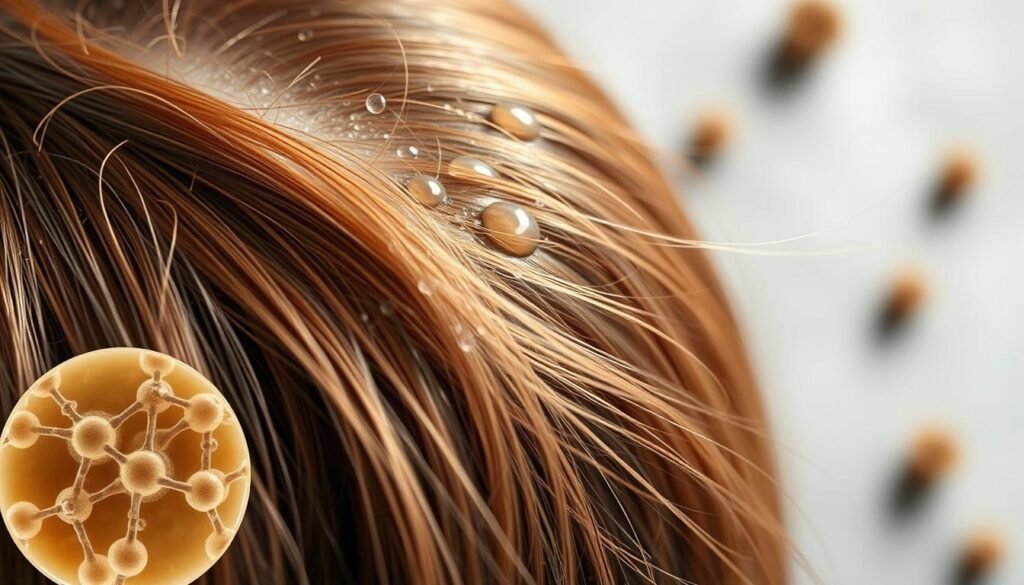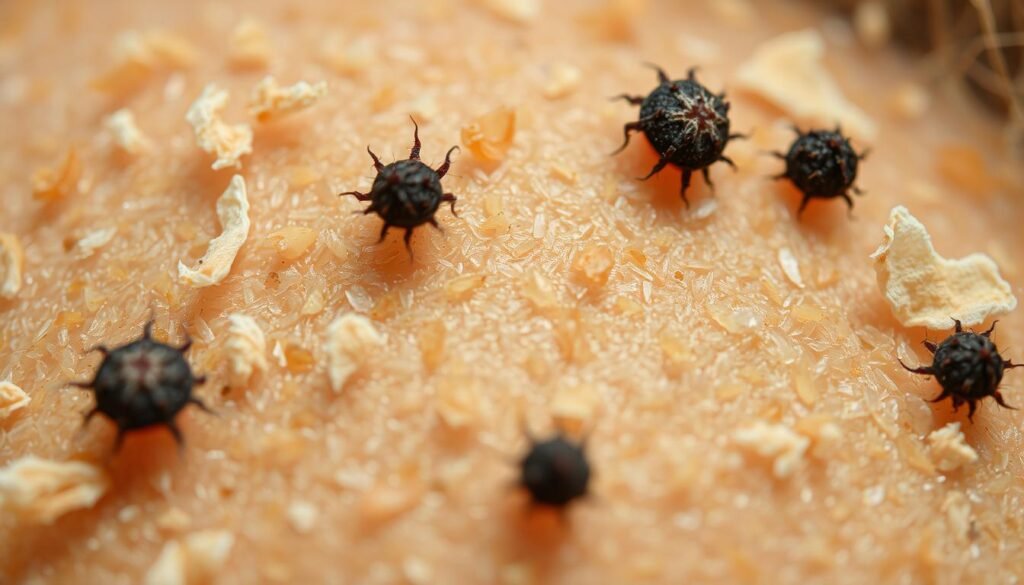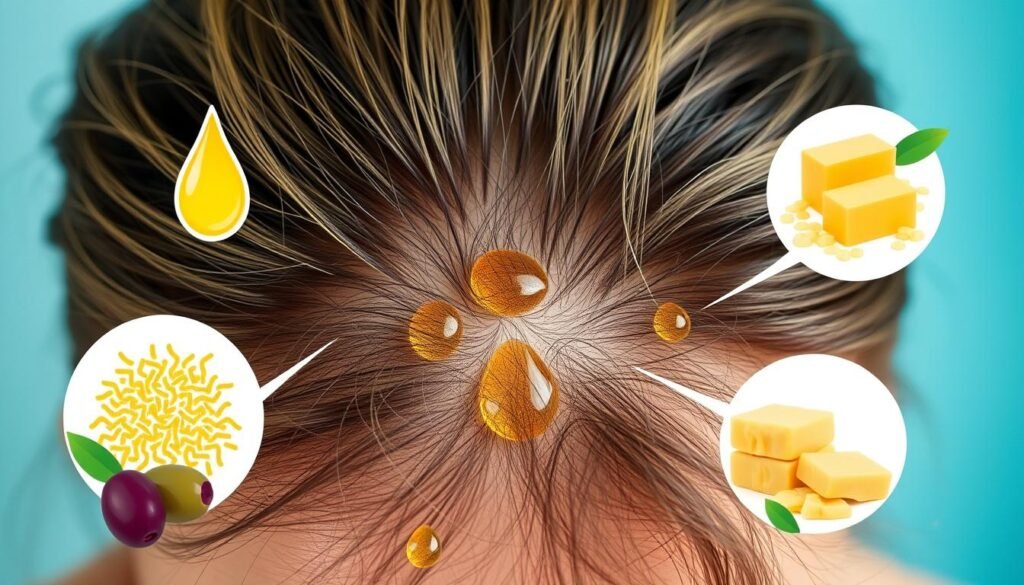Did you know more than half of people worldwide experience dandruff at some point? This condition can be a mild issue or lead to severe irritation, known as seborrheic dermatitis. Studies show those with dandruff may react more to oleic acid, a common fat in our scalp’s oil. This fact underlines a big link between oleic acid and dandruff. It’s key to know how this fat impacts scalp health and causes flakiness.
Oleic acid plays a major role in dandruff. It can make skin cells shed faster, worsening dandruff. This fat, mixed with imbalance of bacteria and fungi, makes dandruff hard to manage. In this piece, we will delve into how oleic acid affects the scalp’s health and dandruff.
Key Takeaways
- More than 50% of individuals experience dandruff, with significant sensitivity linked to oleic acid.
- Oleic acid promotes skin cell turnover, contributing to dandruff development.
- Dysbiosis between bacteria and fungi on the scalp plays a crucial role in dandruff.
- Regular cleansing and targeted treatments can effectively address dandruff symptoms.
- Understanding the connection between sebum and dandruff can aid in better scalp care.
Understanding Dandruff: A Complex Scalp Condition
Dandruff affects nearly half of all adults globally. It’s often thought to be caused by a dry scalp, but it’s actually due to oiliness. This confusion can make things worse for those dealing with dandruff. Experts believe it signifies a deeper scalp issue, influenced by genetics, changes in hormones, stress, and the environment.
Dandruff can lead to more serious conditions, like seborrheic dermatitis. This problem can affect oily parts of the body, not just the scalp. It usually starts at puberty, peaks in young adults, and then tends to decrease after age 50. Having dandruff can also lead to social and psychological difficulties.
Studies show certain fungi and bacteria can make dandruff worse. For instance, the fungus Malassezia grows more during dandruff flare-ups. A healthy scalp microbiome is key for good scalp health. Using the right products, like Holistic Hair Sensitive Shampoo with lavender, chamomile, and apple cider vinegar, can really help. These ingredients balance the scalp’s pH level.
Good scalp care routines are vital to prevent more dandruff. Managing dandruff well requires looking at diet, stress, and staying hydrated. Understanding the importance of scalp health can lead to better hair care practices and dietary choices. To learn more about Omega-3 fatty acids and dandruff, check out this useful link.
What Causes a Flaky Scalp?
A flaky scalp comes from different issues, often due to seborrheic dermatitis. This scalp problem touches millions globally, impacting life quality. It involves factors like genes, how much scalp oil is made, and Malassezia fungus presence.
About half of people worldwide react badly to oleic acid. This makes dandruff and seborrheic dermatitis worse. On a healthy scalp, cells renew every 30 days. But with a flaky scalp, this process is much faster, showing flakes or scales.
To fight this, treatments target the Malassezia fungus that lives on our skin. Anti-dandruff shampoos with selenium sulphide, piroctone olamine, or zinc pyrithione help. Shampoos with piroctone olamine and salicylic acid work better than those with zinc pyrithione.
Probiotics can also help people with ongoing flaky scalp problems. They restore a healthy balance on the scalp. This makes it hard for bad fungi to grow.
Look for signs that you might need a doctor’s help. Like silvery-white skin patches, really bad itching that causes bleeding, or flaking with hair loss. Knowing these signs helps take care of scalp health well.
The Role of Sebum in Scalp Health
Sebum is the natural oil our skin makes. It’s vital for keeping our scalp healthy. This oil acts as a shield, keeping the scalp moist and feeding hair roots. If we didn’t have sebum, our scalp could get dry and flaky.
When we hit puberty, we make more sebum because of hormone changes. A little bit of sebum is good, but too much can cause dandruff. This is because it can feed the fungi that lead to dandruff.
Eating foods like fruits, yogurt, and probiotics can help with dandruff. Anti-dandruff shampoos with zinc pyrithione or selenium sulfide are also effective. Though some like using tea tree oil or apple cider vinegar, their effectiveness isn’t well-proven.
It’s key to wash your hair just right to manage sebum. If you have dandruff, washing every 2-3 days might help. For general scalp health, washing every 4-7 days is okay. It’s best not to apply too much oil directly, as it can increase flaking.
| Factors | Impact on Sebum | Recommendations |
|---|---|---|
| Diet | Rich diet can lower dandruff flares | Include fruits, yogurt, and probiotics |
| Cleansing Frequency | Balance oil production | Every 2-3 days for flaking; 4-7 days for routine |
| Oils | Can worsen inflammation and flaking | Avoid direct application to scalp |

Malassezia Fungus: The Key Player in Dandruff
The Malassezia fungus is closely linked to dandruff and seborrheic dermatitis. It flourishes on the scalp, feeding on the oils our skin produces. It’s a key part of the skin’s microbiome, especially in oily areas like the scalp, face, and upper back.
This fungus comes in 18 different types, all affecting the skin in various ways, including causing dandruff. These fungi are unique because they thrive in oily environments. Their genes help them use oils, but they can’t make oils themselves. This makes them rely on the oils our body makes.

Research connects Malassezia to scaly scalp patches and discomfort. Specifically, M. restricta plays a big role in dandruff and seborrheic dermatitis. People with dandruff tend to have a lot more M. restricta on their scalps than those without. This shows how it might cause skin issues.
Malassezia interacts with our immune system, releasing allergens. This shows how important it is to understand it for skin health. Knowing how Malassezia works can help find good treatments for dandruff and related problems. For deeper insights, check out this study on Malassezia.
| Malassezia Species | Associated Conditions | Prevalence on Scalp |
|---|---|---|
| M. restricta | Dandruff, Seborrheic Dermatitis | High |
| M. globosa | Folliculitis, Psoriasis | Moderate |
| Other species | Atopic Dermatitis, Skin Irritations | Varied |
Oleic Acid and Dandruff: The Link to Flaky Scalp
Oleic acid plays a big role in scalp health, affecting how quickly skin cells renew. When too many skin cells pile up, the scalp gets flaky. For some, oleic acid makes their scalp irritation worse, leading to more flakes.
How Oleic Acid Affects Skin Cell Turnover
Oleic acid can speed up how fast skin cells renew. When this happens too quickly, dead skin cells can build up, resulting in dandruff. To keep your scalp healthy, it’s key to find a balance. Washing your scalp every 2-3 days can help manage flakiness and maintain health.
Research Findings on Oleic Acid Sensitivity
About half of people may react to oleic acid, which is linked to more dandruff and seborrheic dermatitis. Research has found that shampoos with piroctone olamine and salicylic acid are effective for those with this sensitivity. Learning more about oleic acid’s effects can help in taking care of your scalp. Understanding how oleic acid impacts skin cells is crucial for better scalp health.

Symptoms of Dandruff and Related Scalp Conditions
Dandruff shows up in ways that really affect people’s comfort and self-esteem. The most obvious sign is visible flakes on the scalp or clothes. This can lead to feeling embarrassed. Itching and irritation are also common, making things even more uncomfortable. Did you know nearly 75% of individuals will experience dandruff symptoms at some point?
For those with oily skin, excess sebum can worsen symptoms, causing more flakes. Dry scalp dandruff often happens in the winter. This is because of hot water and tough shampoos removing moisture. Each type hints at different scalp issues, needing unique solutions.
Dandruff can really affect how someone feels about themselves. It can make them shy away from others, hurting their mental health. Knowing if you have regular dandruff or something like seborrheic dermatitis is crucial. The latter has more severe symptoms and might need a doctor’s help.
| Symptom | Description | Related Scalp Conditions |
|---|---|---|
| Visible Flakes | White or yellowish flakes on hair or shoulders | Dandruff, Dry Scalp Dandruff |
| Itching | Persistent urge to scratch the scalp | Dandruff, Seborrheic Dermatitis |
| Irritation | Burning or stinging sensation | Dandruff, Scalp Psoriasis |
| Oily Scalp | Excess oil accumulation leading to clumped flakes | Dandruff |
| Dry Scalp | Flaking due to low humidity or hot water usage | Dry Scalp Dandruff |
How to Treat Flaky Scalp Effectively
Dealing with a flaky scalp needs more than one solution. This includes special shampoos and home treatments. If you have dandruff, it’s key to find treatments that handle both the cause and its effects. Caring for your hair the right way can make your scalp healthier and fix the flakiness.
Medicated Shampoos for Dandruff Control
Shampoos with certain ingredients, like piroctone olamine and salicylic acid, are effective against dandruff. They fight a fungus called Malassezia and keep the scalp’s bacteria balanced. Washing your hair with these every 2-3 days can really help. It reduces symptoms and stops flakes from building up. Among these, shampoos with piroctone olamine are especially good.
Incorporating Natural Remedies and Hair Care Products
Natural remedies can also play a big part in hair care. Coconut oil is great for moisturizing and calming the scalp because it fights microbes. You should apply it lightly and wash it off after a little while. Essential oils like tea tree and peppermint are good too. They fight fungus and reduce swelling. Using these regularly can make your scalp and hair healthier.
Sometimes, people may need help from experts when symptoms are bad, like lots of flakes, bleeding, or hair loss. For those looking into how to treat flaky scalp, picking the right mix of medicated shampoos and natural remedies can lead to success.
Maintaining a Healthy Scalp Microbiome
Having a balanced scalp microbiome is key to a healthy scalp and dandruff prevention. An imbalance can lead to problems like dandruff. The health of your scalp is closely tied to the mix of microorganisms living on it. By keeping a strong microbiome, you help your scalp stay healthy.
Here are some ways to keep your scalp microbiome healthy:
- Gentle Cleansing: Clean your scalp every 2-3 days when it flares up. For regular care, every 4-7 days is good. This helps manage oil and stops harmful microbes from growing.
- Targeted Products: Shampoos with piroctone olamine work well against dandruff. They’re even better than those with zinc pyrithione for flaky scalps.
- Topical Probiotics: Putting topical probiotics on your scalp can create a balanced microbiome. Research shows they’re good for your scalp health and reduce dandruff symptoms.
- Dietary Considerations: Eating foods rich in biotin and nutrients supports your microbiome. This diet helps your skin and nutrient absorption.
- Limit Direct Oil Application: Don’t put oils directly on your scalp. They can make inflammation and flaking worse.
If you have severe symptoms like hair loss or inflamed skin, see a professional. Knowing how the scalp microbiome and dandruff prevention are linked can guide effective care for a healthy scalp.
| Strategy | Importance |
|---|---|
| Gentle Cleansing | Controls excess oil and maintains microbial balance |
| Targeted Products | Enhances dandruff prevention and treats flaky scalp |
| Topical Probiotics | Restores microbial balance and improves scalp health |
| Dietary Considerations | Supports microbiome diversity and nutrient absorption |
| Limit Direct Oil Application | Prevents exacerbation of inflammation and flaking |
Conclusion
Oleic acid and dandruff have a key link for those caring for their scalp. Dandruff comes from the mix of sebum and the Malassezia fungus. This can get worse with oily skin, stress, and what we eat. About half of people are sensitive to oleic acid. This shows why it’s vital to pick hair care that matches our scalp’s needs.
To handle dandruff well, we need plans that work. Using special products like the Sensitive Shampoo and Herbal Finishing Rinse Concentrate from Holistic Hair helps. These products lessen oil and fight fungi. Clinical studies prove they significantly cut down dandruff.
Living healthy affects our scalp too. Eating right, staying hydrated, and managing stress matters. Knowing all that affects dandruff lets us move towards a healthier scalp and less flakiness. Oleic acid is just one piece of the puzzle in caring for our scalp.